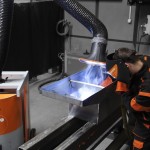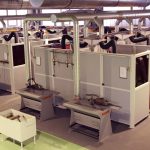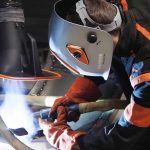Welding fume extraction done right: This is how you bring the extraction arm into position
Extraction arms are the most commonly used equipment in Germany for welding fume extraction. The correct handling is decisive with regards to effective capture of welding fumes. A high coverage rate and thus the effectiveness of occupational safety largely depend on this. We explain which standards apply for the use of extraction arms and what you have to consider during handling.
Many welders know this situation: The extraction arm of the extraction system is very stiff for welding processes using local extraction. Tracking is often cumbersome and one may tempted to quickly work on some areas without first moving the extraction arm into the right position. However, correct usage and quality are important for welding fume extraction.
For example, the friction disks for position locking fitted into the extraction arm are a possible reason for inadequate tracking, since no spring support is available or it is badly dimensioned. This makes the extraction arm stiff and uncomfortable to position. This means that the incorrect handling of an extraction arm can quickly become dangerous and the exposure to welding fumes can be significantly increased.
Correct tracking of the extraction arm: essential for occupational safety
Initially, welders have the greatest duty: The correct position or rather the tracking is not done by the extraction system, but it is the welder himself who is responsible for his own health. The extraction hood should always be aligned to the welding seam. Ideally, it is positioned at a distance of approx. 30 centimeters diagonally above the welding point to ensure that the welding fumes are fully extracted. It must, however, not obstruct the view of the welding point.
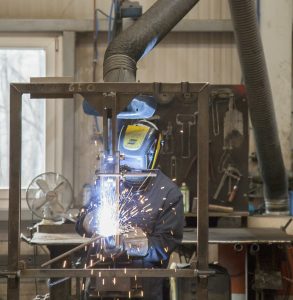 In practical applications that is not always a given, which means that avoidable mistakes can often be observed: The extraction hood rests, for example, above the welder’s head towards the welding point and is not tracked at any point. Thus, he first inhales the welding fumes before it they are captured by the extraction plant. Or the extraction arm is positioned too far away from the source of the welding fumes and the extraction effect becomes ineffective.
In practical applications that is not always a given, which means that avoidable mistakes can often be observed: The extraction hood rests, for example, above the welder’s head towards the welding point and is not tracked at any point. Thus, he first inhales the welding fumes before it they are captured by the extraction plant. Or the extraction arm is positioned too far away from the source of the welding fumes and the extraction effect becomes ineffective.
Wrong handling decreases coverage rate
And this is what welders should always keep in mind: Would they remove their welding helmet at the highest intensity of the welding arc? A similar question should be asked with regards to welding fume extraction even if the consequences are not as direct as the dazzling effect. Do I really want to put my own health at risk simply because I don’t want to track the extraction arm?
As soon as a part of the welding fumes passes the extraction hood and is thus not captured, then even the best possible extraction rate of the filter of more than 99.9% becomes practically immaterial and air purification is no longer fully ensured. The combination of coverage rate and filter performance ultimately results in the effectiveness of a welding fume extraction system.
The coverage rate differs from the extraction rate, which is often the focus with regards to occupational safety during welding. It refers simply to the quality of the filter and its tight fit in the equipment. Here, a distinction is made between several filter classes , of which the most powerful ones have an extraction rate of more than 99.9%. In plain language, this means that 99.99% of the hazardous substances are extracted from the contaminated air. The coverage rate, however, provides an indication of how much of the contaminated air is extracted and transported to the filter in the first place.
Look at this calculation example: If the coverage rate is only 75% due to wrong handling and the filter performance 99%, then the efficiency overall is at 25.75%. This means that 25.75% of the hazardous substances remain in the air that the welders breathe in or in the hall air. If in this case, you had an extraction plant in use with an efficiency of 100%, you would still be left with 25% of hazardous substances.
The ideal extraction arm: smooth-running and with added value for the welder
Technology is still decisive, however, for finding the right position quickly. The extraction arm of extraction equipment should impair the work process as little as possible. The welder will only accept and use the extraction arm if it can be tracked easily, is ergonomic and does not hinder work. Physically, the best solution for welding fume extraction with a very high filter performance does bring little benefit if the extraction arm is not tracked since it obstructs the work.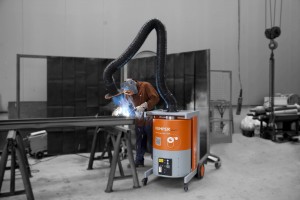
The necessary condition for smooth tracking of flexible extraction arms is specified in the standard DIN EN ISO 15012-4. According to this, a flexible extraction arm has to be movable in any direction using the handle on the hood with a force of at most 60 Newton. For this, the extraction arm has to keep its position across the entire range of the working area once this force is removed. Ideally, the welding fume extraction should also be fitted with an extraction arm which is easy to control with just one hand and keeps each position by itself.
This allows the welder to fully focus on the workpiece. (For more information about quality, please read more details here.) An extraction hood with throttle valve which can be pivoted by 360 degrees promotes ergonomy. If the cover is flanged at the sides, then this prevents suction of “false air” and thus achieves a significantly higher coverage rate than a purely oval shaped hood.
Three reasons to correctly position the extraction arm
The correct position paired with easy tracking is thus elementary for the extraction effect – and that for the following reasons:
- Welding fume extraction without hazardous substances in the breathing zone is only possible with a position of 30 centimeters distance diagonally from the body. Then the welding point is still within the suction range of the extraction hood.
- This also means that the extraction arm remains in the welder’s field of vision so it can be tracked quickly. He does not have to look around for long, can easily move the extraction arm with one hand during the welding process and thus fully concentrate on his work.
- A light ideally integrated into the extraction hood and thus resulting in better lighting conditions at the front improve the view of the workpiece.



